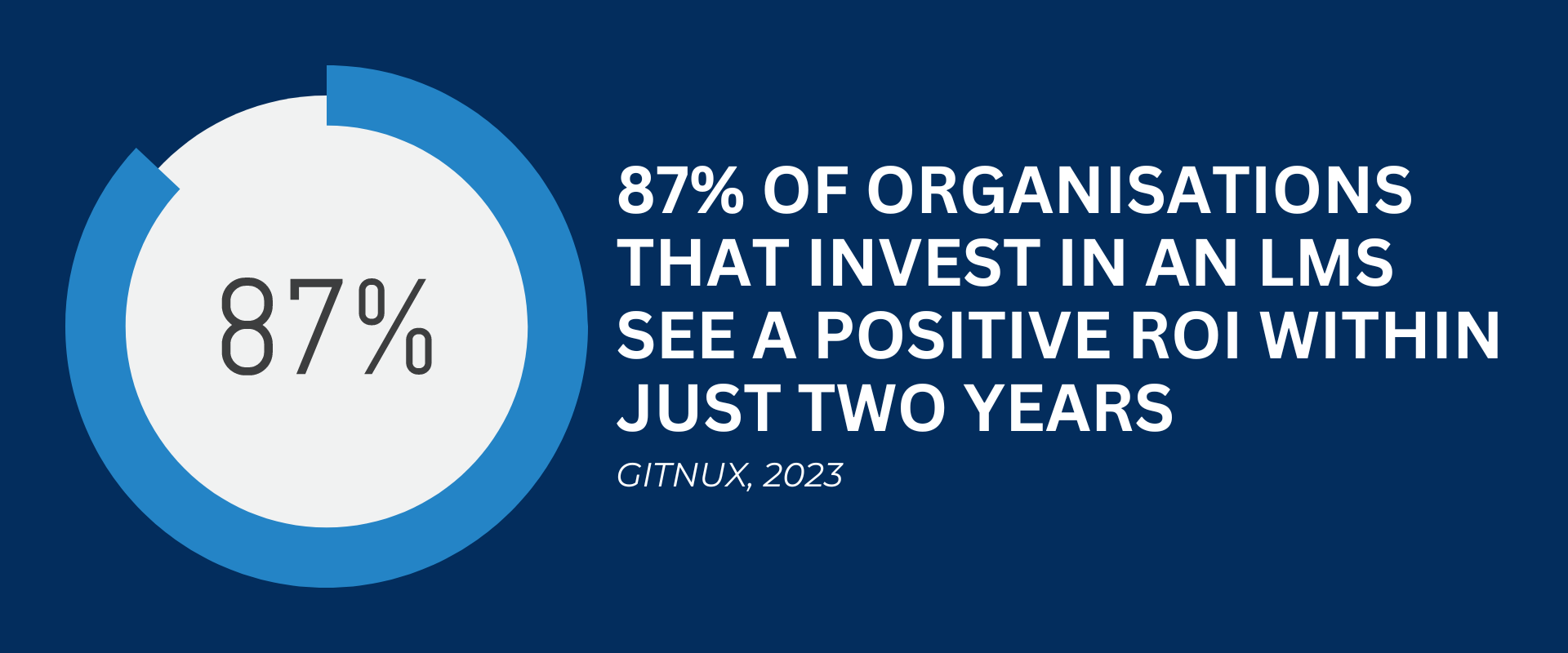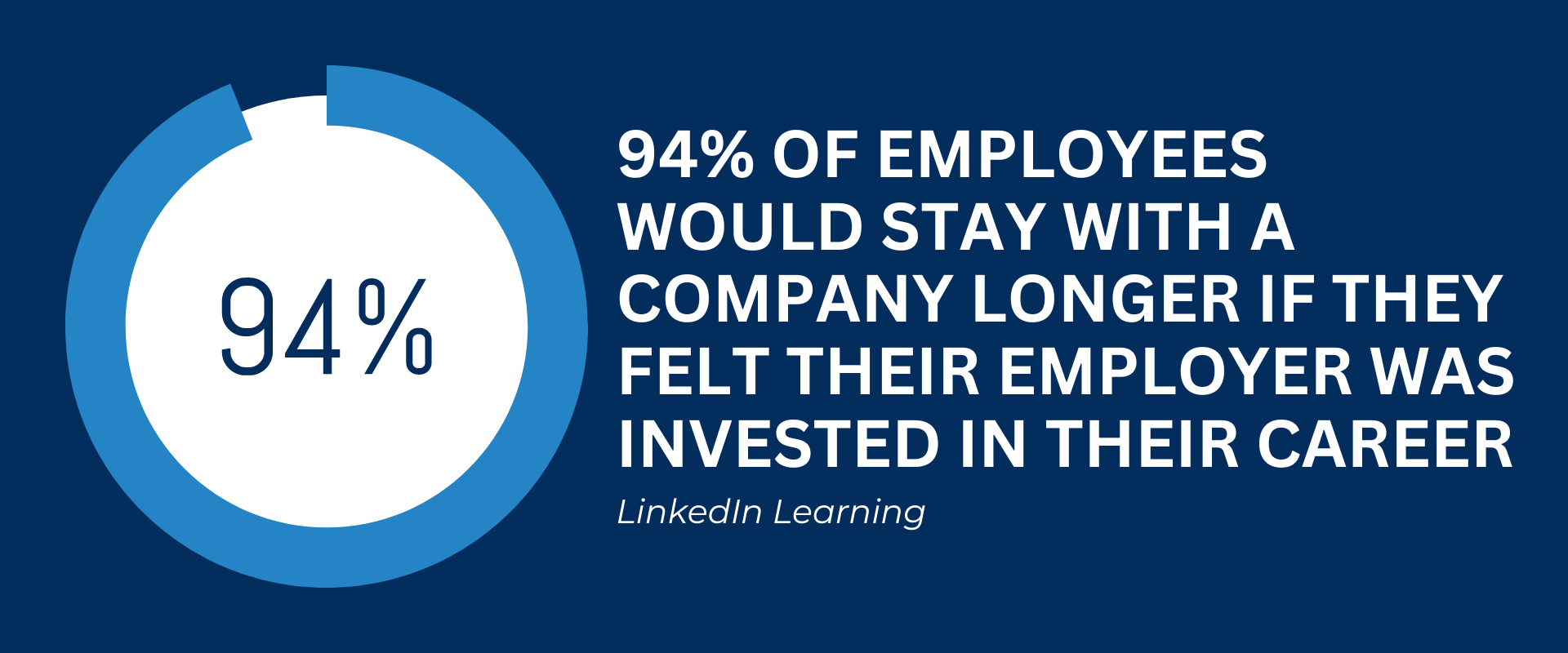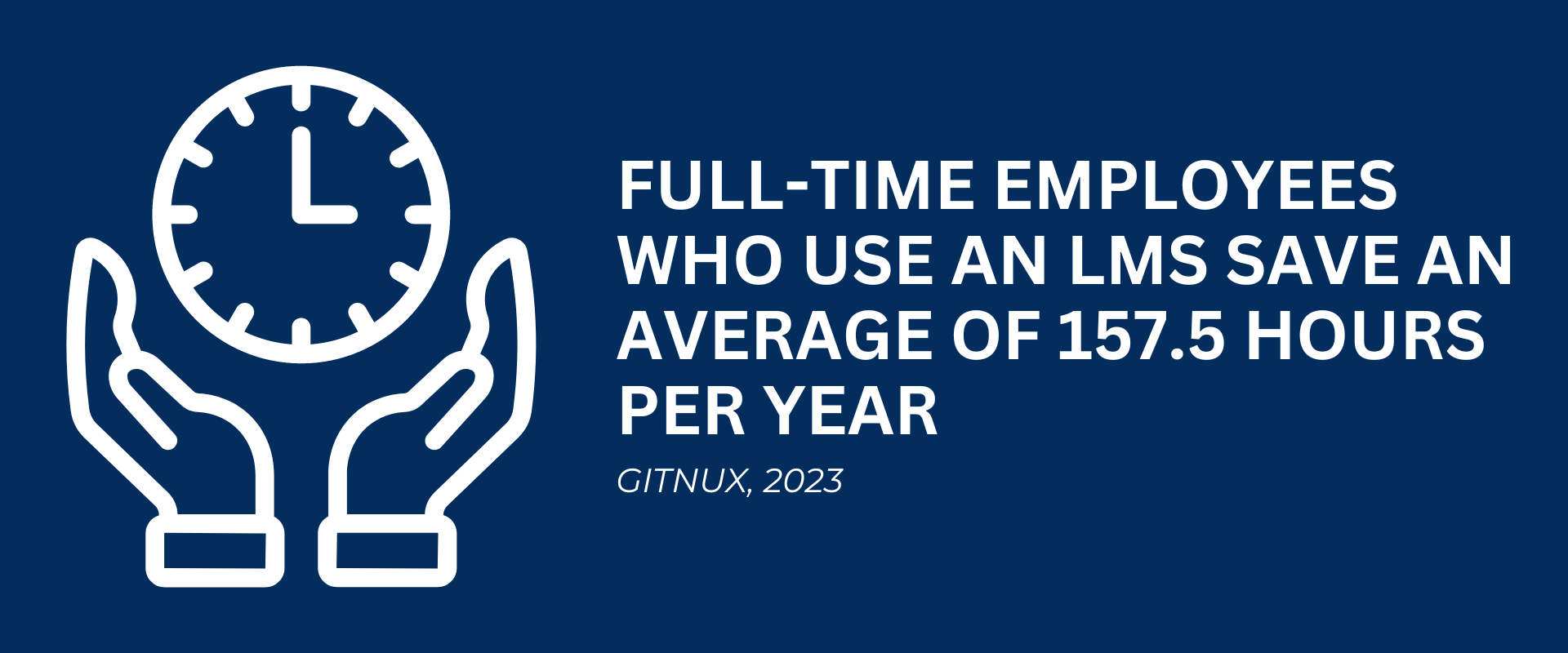Calculating LMS ROI for training programmes and employee development
Assessing the Return on Investment (ROI) for your Learning Management System (LMS) and associated training initiatives requires a thorough evaluation of both the expenses incurred and the benefits gained. Here's how it breaks down:
1. The Core formula
The basic formula for calculating LMS ROI is as follows: LMS ROI = (Net Benefits / Total Cost of LMS) x 100
2. Identifying and calculating total costs
This involves both direct and indirect expenses associated with the LMS and training. Direct costs include:- LMS software licenses or subscription fees.
- Implementation fees, customization costs for the platform.
- Content creation and licensing fees for training materials.
- Training for administrators and employees on how to use the LMS.
- Employee time spent in training (calculating the value of this time based on average wages).
- Administrative time spent on managing and tracking training initiatives
- Facility overhead, travel, and material expenses (if applicable for any in-person components).
3. Measuring tangible benefits
These are quantifiable improvements that can be attributed to the LMS and training programs:
- Increased productivity
- Reduced training time
- Faster onboarding
- Decreased costs associated with traditional training
- Reduced employee turnover
- Increased revenue generation
- Improved compliance
4. Considering intangible benefits
While harder to quantify, these still contribute significantly to the LMS's value:
- Enhanced employee engagement and satisfaction
- Stronger learning culture
- Better decision-making
5. Applying the formula
Once you have identified and quantified the costs and benefits, plug them into the ROI formula:
LMS ROI = (Total Benefits - Total Costs) / Total Costs x 100
Example
Let's consider a scenario based on information from Moodle:
Total LMS implementation and annual costs: £10,000
Total benefits realised in the first year (cost savings, productivity gains, etc.): £20,000
LMS ROI = ((£20,000 - £10,000) / £10,000) x 100 = 100%
This indicates that for every pound spent on the LMS, the company generated £2 in benefits.
When organisations embark on the process of choosing the perfect LMS to fulfil their L&D goals and objectives, most information about the platform can be obtained instantly. Information on determining factors such as system features, functionality, integration options and upfront costs can be found with simple research or via conversations with an LMS provider. However, one important factor in the decision-making process is determining the ROI, and estimating this will require a little more legwork. Our comprehensive eBook is designed to guide you through a step-by-step process of calculating your ROI, with formulas and additional information to help you maximise your investment.
In this blog, we're giving you an exclusive glimpse into what you can expect from our free eBook. Once you’re ready to read it, click here to download your free copy!
What to expect from our free eBook:
Extract from p2:
The purpose of this eBook is to highlight a number of areas that business leaders can use to determine the business impact of their e-learning platforms. Whether you are investing in an LMS for the first time or are unhappy with your current e-learning platform and are considering switching, as you make your way through the book, you’ll learn not only how to estimate Return on Investment (ROI) for your LMS, but also some practical steps on how to maximise your ROI.
In this book, you'll find:
- The definition of and use cases for Return on Investment (ROI)
- How to set measurable goals and benchmarks
- Steps and formulas to calculate the business impact of your training programmes
- Tips to maximise your LMS ROI
- LMS features that enhance your investment
What is ROI?
ROI is simply the financial metric for evaluating the financial consequences of investments and related actions. ROI represents the financial value that can be derived from an investment.
When it comes to assessing the ROI of an LMS there are 3 main areas to consider:
- Does it contribute to improving business performance?
- Does it contribute towards adding revenue?
- Does it contribute towards saving money?
Improved business procedures
An LMS can help you simplify most of the steps required in conducting many aspects of L&D training. The advantages of pooling most of these tasks onto a single LMS platform are high, resulting in much more efficient processes. 
Some examples of increased business proficiency include:
- Custom reporting and automated report scheduling
- Meeting compliance and regulatory requirements
- Having a scalable LMS that can grow with your organisation will make it easier to expand and serve more learners without increasing staff admin costs
- Save time and resources with LMS automation
Making money
Most business decisions are swayed by whether or not something will make the business money - and utilising a learning management system is no different.

- An LMS can make a significant difference in attracting and retaining top talent - this will have a direct and measurable impact on your company's bottom line
- Sell courses online - create, manage and sell your e-learning content
Saving money
Every business watches how it spends its money and investing in an LMS provides a great way to save money on training and learning.

- Using an LMS can significantly reduce corporate training expenses
- Standardise and consolidate your L&D practices across the entire organisation – rather than spending money on multiple training tools across separate departments
- Create a record of valuable ‘corporate’ knowledge and save money by avoiding lost productivity
Calculating ROI
Extract from p11:
Your online and offline training investments need to deliver quantifiable returns that can be seen in your organisation’s bottom line. Senior executives will evaluate your planned programme performance based on costs and outcomes (financial value) driven by committed investments. You need to calculate the ROI by comparing the expected benefits with the costs. This is easier said than done, as it can be very tricky depending on the use case(s) that lie behind the reasons for your decision to purchase an LMS. Indeed, there may be a number of components to factor in, depending on your business case.
The 4 key steps involved in determining your LMS ROI are:
- Set measurement goals
- Define the tracking and measurement approach
- Aggregate the estimated costs of your e-learning project
- Assess the estimated gains of your e-learning project
ROI formula
With ROI, we focus on the net benefits of the training - the benefits minus the costs. The formula for ROI looks like this:
 But calculating ROI isn’t as simple as just knowing a formula. What comes next are the necessary steps you’ll need to undertake in order to measure the ROI of your new LMS training initiative.
But calculating ROI isn’t as simple as just knowing a formula. What comes next are the necessary steps you’ll need to undertake in order to measure the ROI of your new LMS training initiative.
To find out more about these key steps to calculating your ROI, download our free eBook now.
Find out how to maximise your investment
If you've enjoyed reading through the above outline of some of the key aspects discussed within our ROI focussed eBook, be sure to download the full guide for a further, in-depth expansion of these essential points. And, don't miss out on the all-important chapter; Maximising Your Investment. In this section of the eBook, we share our industry insights and expert knowledge to help you optimise your LMS features to enhance your investment and ensure that you are getting true value for money.
Frequently Asked Questions
How do you calculate ROI from LMS implementation?
Calculating LMS ROI requires measuring both cost savings and performance improvements across multiple business metrics.
The standard ROI formula is: (Benefits - Costs) ÷ Costs × 100.
Key ROI Components:
Cost Savings: Reduced travel expenses, eliminated venue rentals, decreased printing costs, and lower administrative overhead
Efficiency Gains: Faster employee onboarding, automated compliance tracking, and streamlined training delivery
Performance Metrics: Improved knowledge retention, higher completion rates, and reduced time-to-competency
Risk Reduction: Better compliance adherence, fewer regulatory penalties, and enhanced audit readiness
Industry Benchmarks: Organisations typically achieve 3:1 ROI within 12 months, with leading implementations delivering up to 40% reduction in training costs while boosting employee retention by 25%.
Measurement Timeline: Track baseline metrics for 3-6 months pre-implementation, then measure quarterly improvements in training efficiency, employee performance, and compliance outcomes.
Hubken Group's Totara Learn implementations include comprehensive dashboards and analytics tools that help keep track of these metrics, helping organisations demonstrate measurable business impact to stakeholders.
What is the average ROI timeline for LMS investments?
Most organisations see positive LMS ROI within 6-12 months, with full return typically achieved by month 18. The ROI timeline varies by organisation size and implementation complexity:
- Months 1-3 (Implementation Phase): Initial costs with minimal returns, focus on user adoption and system optimisation
- Months 4-6 (Early Adoption): First measurable savings from reduced travel costs and administrative efficiency
- Months 7-12 (Full Deployment): Significant ROI emerges through improved training completion rates and reduced onboarding time
- Year 2+: Sustained 200-400% ROI through enhanced employee performance and retention
- Quick user adoption (80%+ engagement within 90 days)
- Effective change management and training programs
- Integration with existing business systems
- Regular content updates and platform optimisation
ROI Milestones:
- Break-even typically occurs at month 8-10, with peak ROI achieved when training completion rates exceed 85% and employee time-to-competency decreases by 30%+.
How do small vs. large organisations differ in LMS ROI expectations?
LMS ROI expectations and timelines vary significantly between organisation sizes, with different priorities and measurement approaches:
Small Organisations (1-100 employees):
- ROI Focus: Cost reduction and efficiency gains
- Timeline: 3-6 months to break-even, primarily through reduced travel and venue costs
- Key Metrics: Training cost per employee, time savings, compliance achievement
- Expected Returns: 150-250% ROI within 12 months
Budget Range: £5,000-£25,000 annual investment
- ROI Focus: Scalability and standardization benefits
- Timeline: 6-9 months to positive ROI through improved onboarding efficiency
- Key Metrics: Employee time-to-productivity, knowledge retention, training consistency
- Expected Returns: 200-300% ROI within 18 months
- Budget Range: £20,000-£100,000 annual investment
- ROI Focus: Strategic performance improvements and risk mitigation
- Timeline: 9-15 months for full ROI due to complex implementation
- Key Metrics: Enterprise-wide compliance, talent development, competitive advantage
- Expected Returns: 300-500% ROI within 24-36 months
- Budget Range: £100,000+ annual investment
Critical Success Factors: Regardless of size, organisations achieving highest ROI focus on user adoption (target 85%+ engagement), content quality, and integration with existing business processes.
Hubken Group tailors Totara Learn implementations to organisation size, ensuring realistic ROI expectations and measurement frameworks that align with business objectives and available resources.
Why should I use Hubken for employee onboarding?
Lorem ipsum dolor sit amet, cum eu graecis albucius accusata, vivendo probatus. Nihil facete ut vix, an cum malorum patrioque. Lorem ipsum dolor sit amet, cum eu graecis albucius accusata, vivendo probatus. Nihil facete ut vix, an cum malorum patrioque.
Why should I use Hubken for employee onboarding?
Lorem ipsum dolor sit amet, cum eu graecis albucius accusata, vivendo probatus. Nihil facete ut vix, an cum malorum patrioque. Lorem ipsum dolor sit amet, cum eu graecis albucius accusata, vivendo probatus. Nihil facete ut vix, an cum malorum patrioque.
What KPIs should executives track to measure learning platform ROI?
To measure the ROI of a learning platform, executives should track KPIs that reflect both learning effectiveness and business impact. Key metrics include training completion rates, knowledge retention, skill application, and learner engagement. On the business side, monitor improvements in job performance, time-to-proficiency, employee retention, and cost savings. By aligning training goals with business objectives and using a mix of data-driven insights, organisations can clearly demonstrate the value of their L&D investment.
What's the realistic ROI timeline for LMS implementation in UK mid-sized companies?
For UK mid-sized companies, LMS ROI typically unfolds in stages. In the short term (3–6 months), businesses often see savings from reduced training costs and admin workload. Over the mid-term (6–12 months), benefits like faster onboarding, improved compliance, and early signs of employee engagement emerge. Long-term ROI (1–2 years and beyond) includes measurable gains in productivity, employee retention, and business performance, especially when the LMS is well-integrated, widely adopted, and aligned with strategic goals.
How do learning platforms / LMSs contribute to revenue growth and increased productivity?
An LMS boosts productivity by streamlining training, reducing time-to-competency, and enabling employees to develop role-specific skills faster. It cuts training costs through automation and scalability, allowing organisations to train more people with fewer resources. Better-trained staff improve customer satisfaction and retention, directly supporting revenue growth. Built-in analytics also help measure performance and optimise learning strategies for long-term business impact.
How can I calculate the training cost savings associated with an LMS?
To calculate LMS-related training cost savings, compare the total cost of implementation and operation against measurable benefits like reduced training time, lower travel and venue costs, and faster onboarding. Built-in reporting tools can simplify data tracking, while ongoing analysis helps demonstrate long-term value. By quantifying both time and cost savings, you can clearly show the ROI of your LMS investment.






